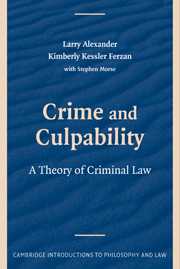Book contents
- Frontmatter
- Contents
- Acknowledgments
- PART ONE Introduction: Retributivism and the Criminal Law
- PART TWO The Culpable Choice
- PART THREE The Culpable Act
- 5 Only Culpability, Not Resulting Harm, Affects Desert
- 6 When Are Inchoate Crimes Culpable and Why?
- 7 The Locus of Culpability
- PART FOUR A Proposed Code
- Epilogue
- Appendix
- Bibliography
- Index
6 - When Are Inchoate Crimes Culpable and Why?
Published online by Cambridge University Press: 05 June 2012
- Frontmatter
- Contents
- Acknowledgments
- PART ONE Introduction: Retributivism and the Criminal Law
- PART TWO The Culpable Choice
- PART THREE The Culpable Act
- 5 Only Culpability, Not Resulting Harm, Affects Desert
- 6 When Are Inchoate Crimes Culpable and Why?
- 7 The Locus of Culpability
- PART FOUR A Proposed Code
- Epilogue
- Appendix
- Bibliography
- Index
Summary
Having argued that results are neither necessary nor sufficient for blameworthiness or punishability, we must still answer the question of what type of action is necessary for the actor to be said to have acted culpably. Although this problem is traditionally addressed within the doctrinal rubric of the actus reus for incomplete attempts, the problem for us applies more generally. We must specify an actus reus formulation for all crimes.
There are various potential actus reus formulations, drawn along the continuum from the time the actor forms an intention to impose a risk of harm to the time when he believes he is unleashing that risk and it is no longer within his (complete) control. We contend that it is only at the time the actor engages in the act that unleashes a risk of harm that he believes he can no longer control (through exercise of reason and will alone) that he has performed a culpable action.
In this chapter, we begin by setting forth the principles that underlie our adoption of the “last act” formula. We then survey the various points along the inchoate crime continuum, from the formation of the intention to impose the risk, to the Model Penal Code's intention plus “substantial step,” to the common law's intention plus “dangerous proximity,” to the last act.
- Type
- Chapter
- Information
- Crime and CulpabilityA Theory of Criminal Law, pp. 197 - 225Publisher: Cambridge University PressPrint publication year: 2009

